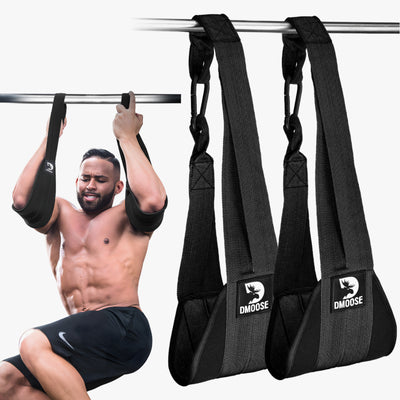Shoulder stiffness can sneak up on anyone. Long hours at a desk, intense training sessions, or even poor posture can leave your deltoids feeling tight and sore. That dull tension makes every press, pull, and overhead move feel heavier than it should.
Deltoid muscle stretching exercises are a simple way to change that. With the right stretches, you can loosen up stubborn knots, restore mobility, and bring back strength to every rep.
Below, we’ll break down 8 effective deltoid stretches that help you move freely, train better, and keep your shoulders feeling powerful.
Anatomy of the Deltoids
The deltoids are a group of three muscles working together to move the shoulder- anterior, posterior, and middle deltoids. The anterior deltoid is the muscle that covers the front of the shoulder. The posterior deltoid covers the back of the shoulder, and the middle deltoid covers the side of the shoulder.
All three muscles work together to lift the arm above the head. The anterior deltoid is responsible for most lifting, whereas the posterior deltoid and middle deltoid work together to stabilize the shoulder joint.
To effectively work all three muscles, it is important to include a variety of exercises in your workout routine. We’ll give you a few great options to perform stretches later in the post.
Related Article: What are Deltoid Muscles? 6 Best Shoulder Isolation Exercises for Men to Get Bigger Deltoids
8 Best Deltoid Muscle Stretching Exercises
These deltoid muscle stretching exercises will help you release shoulder tension, improve mobility, and support better posture. Whether you're looking for a simple deltoid stretch to ease soreness or advanced deltoid stretches to boost flexibility, these moves will keep your shoulders strong and functional.
1. Arm Across Chest Stretch – Loosen Tight Rear Delts

This is one of the most effective rear delt stretch options for easing shoulder tightness. It improves range of motion and helps you stretch deltoid muscles safely. Ideal for anyone with stiff shoulders from lifting or sitting too long, it also promotes better posture. Perform this deltoid muscle stretch after workouts for faster recovery.
How to Perform Arm Across Chest Stretch
- Reach your right arm across your chest.
- Grab it with your left hand and pull gently.
- Keep shoulders relaxed while holding the stretch.
- Maintain for 20–30 seconds, then switch sides.
- Repeat 2–3 times.
2. Standing Phelps Back Slap Stretch – Improve Shoulder Flexibility

This deltoid stretch improves circulation and prepares your shoulders for training. It’s a simple delt stretch that relieves stiffness and keeps your joints mobile. It also supports better athletic performance by activating the shoulder muscles. Include this stretch before lifting sessions to reduce injury risk.
How to Perform Standing Phelps Back Slap Stretch
- Stand upright with feet shoulder-width apart.
- Hug yourself by crossing your arms over your chest.
- Open your arms wide and reach back.
- Alternate between hugging and opening.
- Repeat for 20–30 seconds.
3. Standing Alternating Upper Arm Circles – Boost Shoulder Mobility

This movement is one of the simplest deltoid stretching exercises for improving blood flow. It activates your shoulder muscles and increases joint flexibility. By practicing it daily, you can stretch deltoid muscles effectively and reduce stiffness. Use it as a warm-up to prepare your shoulders for lifting.
How to Perform Standing Alternating Upper Arm Circles
- Stand tall with arms out to the sides.
- Circle arms forward 10 times.
- Reverse and circle backward 10 times.
- Keep your movements smooth and steady.
- Repeat for 2–3 rounds.
4. Stick Pass Around Stretch – Improve Shoulder Rotation

This deltoid muscle stretching move improves rotation and mobility in the shoulders. It’s especially useful for athletes and lifters who perform overhead movements. Doing this regularly helps prevent shoulder strain and improves flexibility. Add it to your pre-workout routine to prepare your shoulders for intense activity.
How to Perform Stick Pass Around Stretch
- Hold a stick or broom with an overhand grip.
- Keep arms straight while moving the stick around.
- Pass it from front to side, then behind your back.
- Continue until you reach the other side.
- Repeat 10 passes in each direction.
5. Standing Reverse Shoulder Stretch – Relieve Rear Delt Tension

This is a powerful rear delt stretch that improves shoulder health and posture. It also eases tension in the upper back and neck area. Doing this regularly prevents stiffness caused by sitting for long hours. Add it to your post-workout routine to improve shoulder recovery.
How to Perform Standing Reverse Shoulder Stretch
- Stand upright and clasp your hands behind your back.
- Gently pull your chin down toward your chest.
- Hold the stretch until tension is felt in your rear delts.
- Stay relaxed while holding for 20–30 seconds.
- Repeat on the other side.
6. Standing Wring the Towel – Enhance Shoulder Rotation

This deltoid muscle stretch improves rotational strength and joint mobility. It’s perfect for warming up before lifting or sports. Regular practice keeps the shoulders flexible and balanced. It’s also a great way to learn how to stretch deltoid muscles safely.
How to Perform Standing Wring the Towel
- Stand upright with arms extended to the sides.
- Rotate one shoulder inward and the other outward.
- Switch directions in a smooth motion.
- Control your posture and avoid rushing.
- Repeat 10–12 times.
7. Doorway Shoulder Stretch – Open Up Tight Front Delts

This anterior deltoid stretch is excellent for opening up the front shoulders and chest. It relieves tightness from heavy pressing movements or poor posture. Regularly performing this front delt stretch improves alignment and reduces injury risk. Include it in your cool-down to keep shoulders flexible.
How to Perform Doorway Shoulder Stretch
- Stand in a doorway with elbows bent at 90 degrees.
- Place forearms against the frame.
- Lean forward gently until your front delts stretch.
- Hold for 20–30 seconds.
- Repeat 2–3 times.
8. Sleeper Stretch – Improve Internal Shoulder Rotation

This is one of the best stretching anterior deltoid movements for increasing internal rotation. It’s perfect for athletes and lifters who want stronger, healthier shoulders. This delt stretch also helps reduce tension after intense workouts. Perform it during cool-downs for lasting shoulder mobility.
How to Perform Sleeper Stretch
- Lie on your side with shoulders stacked.
- Align your elbow with your shoulder.
- Press your wrist down gently with your top hand.
- Stop at a comfortable stretch point.
- Hold for 20–30 seconds per side.
Benefits of Deltoid Stretches
Deltoid muscle stretching exercises do more than loosen tight shoulders. They support strength, mobility, and long-term shoulder health in multiple ways:
Greater Range of Motion
Tight shoulders limit how far you can move. Regular deltoid stretches lengthen the muscles, helping you lift, press, and rotate your arms more freely.
Relieve Pain and Stiffness
Prolonged tension in the delts often leads to soreness and discomfort. Stretching eases that stiffness, making everyday movements and workouts feel smoother.
Boost Blood Flow for Faster Recovery
Stretching increases circulation in the shoulders. Better blood flow brings nutrients to the muscles and helps speed up recovery after tough training sessions.
Lower Your Risk of Shoulder Injuries
Flexible deltoids are less likely to strain or tear. Consistent stretching prepares your shoulders for heavy lifts and sudden movements, reducing injury risk.
Enhance Athletic Performance
When your shoulders move without restriction, you gain more power and control. From pressing overhead to throwing a ball, performance improves with better mobility.
Support Stronger, More Defined Muscles
Healthy, mobile shoulders create a solid foundation for strength training. Pairing deltoid stretches with targeted muscles workouts helps you build stronger, more sculpted shoulders.
Best Time to Stretch Your Deltoids
The best time to stretch your deltoids is immediately after a workout when your muscles are warm and more pliable. Stretching at this point helps reduce stiffness, improves blood flow, and supports faster recovery. If you’re not training, you can still perform a gentle deltoid stretch during breaks at work or after long periods of sitting to prevent tightness. Making deltoid muscle stretching exercises a part of your daily routine keeps your shoulders mobile, improves posture, and prepares your upper body for both training and everyday tasks.
FAQs
1. How do you relieve deltoid pain?
Rest your shoulder, apply ice for 15–20 minutes, and use heat if stiffness persists. If pain continues, consult a doctor for physical therapy or targeted treatments.
2. What does a strained deltoid feel like?
A strained deltoid often causes sharp pain in the shoulder, especially when lifting your arm. Swelling or tenderness may also appear around the muscle.
3. What causes tight deltoids?
Poor posture, repetitive overhead movements, and long periods of sitting are common causes of tight deltoids. Correcting posture and regular stretching can help reduce this stiffness.
4. How often should you train deltoids?
Train your deltoids 2–3 times per week with 8–12 total sets. Adjust volume based on your goals and recovery needs for the best results.
5. How do I know if I need to stretch my deltoids?
If you feel shoulder stiffness, limited range of motion, or discomfort after workouts, deltoid stretching exercises can help restore mobility and reduce tension.
6. What is the best stretch for anterior deltoids?
The doorway stretch is highly effective for the front delts. It opens up the chest and shoulders, reducing tightness from pressing movements.
7. Can stretching help prevent deltoid injuries?
Yes. Regular deltoid stretches improve flexibility, reduce tension, and lower your risk of strains or shoulder impingements during training.
The Bottom Line
Strong and mobile shoulders don’t just happen in the gym. Adding deltoid stretches to your routine keeps your shoulders flexible, pain-free, and ready for every lift. These simple moves can improve performance, reduce injury risk, and help you move better in everyday life. Make stretching your deltoids a habit, and give your shoulders the care they deserve.












